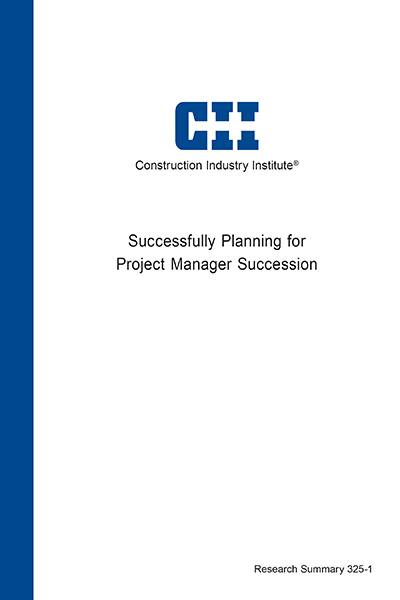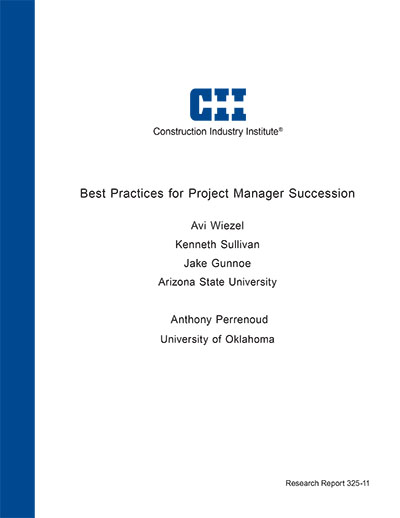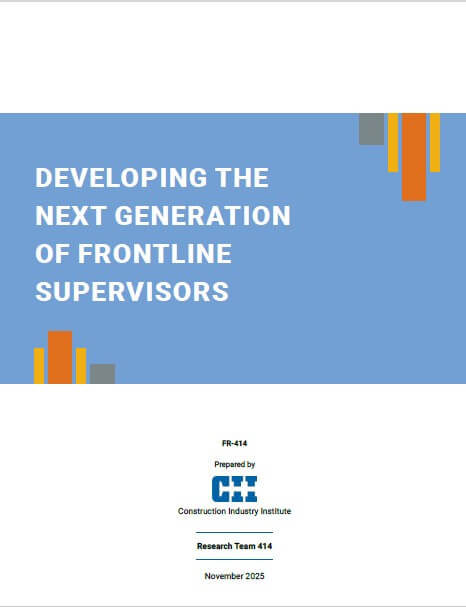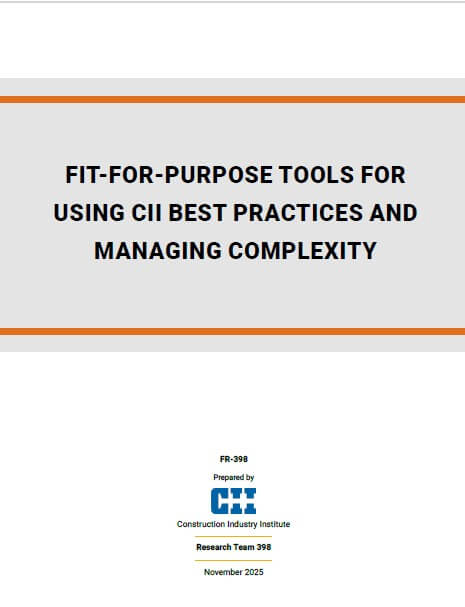
Successfully Planning for Project Manager Succession
Current research shows that, while the majority of the larger companies have a succession plan for their senior leadership, the construction industry does not have widespread, empirically tested and implemented succession models for early to mid-level employees. During normal circumstances, the promotion of mid-level employees into higher positions leaves vacancies that can create instability. In the current demographic situation, the challenges of succession are compounded by a diminishing pool of available talent.
CII tasked Research Team 325 (RT-325) with developing a general framework for succession planning for early to mid-career employees across the construction industry. As it undertook its research, the team identified the critical role of the project manager (PM) in the construction industry. RT-325 elected to focus on the PM career path as the crux of the growing succession problem. The team also found that the main challenge to implementing a succession plan was the early identification of candidates. Thus, the RT-325 research also aimed to isolate the early identifiable traits and behaviors of high-performing employees (commonly referred to as “HiPos”) with high potential to perform as PMs.
In order to better define the succession problem faced in the industry, RT-325 performed an extensive literature search and conducted an industry practices survey of 10 CII member companies. The survey showed that current succession planning procedures do not correlate with the procedures the companies perceived to be most important and did not include lower- to mid-level positions. In response to these findings, RT-325 created two tools that augment company decision-making in regard to succession planning and talent management:
- A guideline of industry succession practices as determined through literature review and by interviewing CII member companies. These practices are simple techniques that are easy to implement and understand.
- A method to early-identify traits of potential future performers. The second tool is based on a statistical analysis of the personality traits of 113 employees. The tool accounts for 47 percent of the factors that relate to potential to becoming a project manager. The analysis also revealed the following key results:
- Performance in the current position is not a good indicator of an employee’s ability to perform at the next level.
- Performance ratings are subjective and do not correlate with other traits or experience within the industry.
- Most personality traits and behaviors are inconsistent across CII member companies.
- Several key traits can help CII member companies to identify previously overlooked employees with high potential to become project managers.
The RT-325 research results identified easy-to-implement practices that allow companies to improve their succession planning methodologies systematically, specifically through what the research team came to call “the 2% extra effort.”
{^widget|(widget_displayname)WatermarkImage|(name)WatermarkImage|(image)%7e%2fCII%2fmedia%2fPublications%2f325_1Figure3.jpg%3fext%3d.jpg|(width)|(height)^}
(RS325-1, p. 7)
The results of the literature review and the industry profiles reveal corresponding results: succession planning methodologies are highly needed in the industry, yet inconsistent across companies and research efforts. As proposed in Chapter 1, the industry is facing a massive talent shift. A demographic overview of 580 early to mid-level employees further justifies this idea. The results of the survey show that the median age of surveyed employees is approximately 51 years old, with the overall distribution highly favoring employees over the age of 50 (the largest group of employees ranging from 50 to 60 years old). The overall distribution box plot is shown in Figure 5.
RT-325 interviewed six CII member companies on their succession planning methodologies. The interviews showed that 50 percent of the companies had a formal succession planning process, but none of the six companies planned succession for entry to mid-level employees. The published literature echoed this finding.
Through the preliminary literature review, RT-325 was able to identify 25 different succession planning practices. The researchers utilized a four-step Delphi method to narrow the set of practices to the 15 that would have the greatest value to the construction industry, and then ranked them in order of importance. (See Table 1.) A focus group of 10 human resource executives from CII member companies was asked to identify which of these 15 practices were actively being implemented within their respective organizations. Table 1 lists the percentage of sampled CII companies implementing each practice in 2015. As can be seen in the table, some of the highest-rated practices were performed in less than half of the participating CII companies.
(RS325-1, pp. 14-15)
Tool 1: Succession Planning for Project Managers
RT-325’s first tool offers a guideline for implementing succession planning best practices. (The succession planning process is discussed fully in Implementation Resource 325-2, A Succession Planning Process for Identifying Project Managers, which offers an extensive look at each phase and its corresponding subsections.) The succession planning process centers on the following six phases:
- Plan – Have a formal plan for approaching successions, approved at the executive level. This plan should align with long-term business goals.
- Assess – Perform a gap analysis, in order to identify the current and future talent needs of the company, and to determine which roles or skills are needed to fill those needs.
- Identify – Evaluate the performance and potential of current employees, in order to identify candidates for succession.
- Prepare – After identifying a successor, implement a personalized development plan to give the potential PM any needed training and to monitor his or her progress.
- Transition – When the succession is ready to take place, introduce the successor to the responsibilities of the new role and provide any necessary mentorship.
- Measure – After the succession has occurred, track the performance of the new PM, to provide continuous improvement for future successions.
(RS325-1, pp. 17-18)
RT-325 collected data from 113 employees across six CII member companies. The minimal sample size to ensure a 95-percent confidence level for this dataset was calculated to be 36; thus, 76 complete data vectors were more than enough to ensure validity. These data were analyzed statistically to correlate personality and behavior traits with the performance and potential ratings these employee received from their supervisors. The results of this analysis yielded two major conclusions:
- Performance ratings do not correlate with any specific trait measured by RT-325.
- The potential to become a PM closely correlates with three specific, measurable traits: managerial experience, influential behavior, and emotional bias.
- Managerial Experience: An employee’s past experience in management or supervisory roles (i.e., multiple subordinates reported to the employee) is the best trait of the three for indicating the potential to perform well as a PM. In interviews and evaluations, supervisors should ask employees to quantify their past leadership experience in terms of years and number of employees supervised. The management experience could have been obtained in any industry, not only in construction.
It is important to note that the supervisory role is different from the role of coordinator. In this context, a supervisor has the authority and responsibility for the performance evaluation of subordinates, while a coordinators does not. The RT-325 research found that, while the role of team coordinator may be a step toward promotion to supervisory positons, it does not correlate with the candidate’s performance as PM.
- Declared Influence: The behavior style of an influential individual is characterized by a tendency to persuade, convince, or influence others (as defined in DISC behavioral assessments; Jones and Hartley 2013). This individual thrives on social recognition and group activities. Employees with influential behavior tend to be outgoing, social, talkative, well-spoken, and animated, and an employee who shows declared influence behavior is more likely to become a high-potential PM.
In interviews and evaluations, supervisors should ask employees about experiences in which co-workers or higher-ups did not agree with their positions. How did the employee respond then, and how would the employee respond in the future? If the employee seems comfortable defending his or her positions and is also comfortable working with others in group settings, he or she is more likely to become a high-potential PM.
- Emotional Bias: The tendency to rely on emotional intuition and personal relationships to make business decisions is negatively correlated with PM success. A highly sentimental emotional bias suggests the candidate has low potential to become a PM. In interviews and evaluations, supervisors should ask the employee for a personal experience in which he or she had to make a difficult decision that personally affected a co-worker (e.g., a firing, disciplinary action, or promotion) If an employee has a history of favoring his or her “friends,” he or she is unlikely to be a high-potential employee. If an employee is able to make business decisions without emotional bias, he or she is more likely to become a high-potential PM.
(RS325-1, p. 22)



